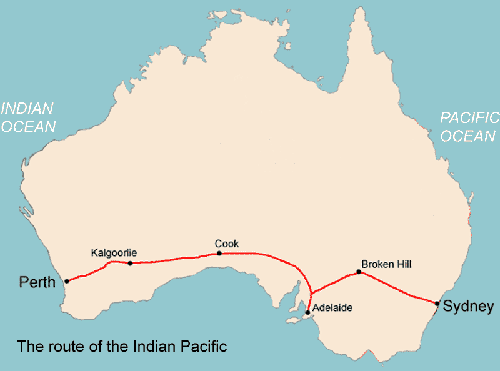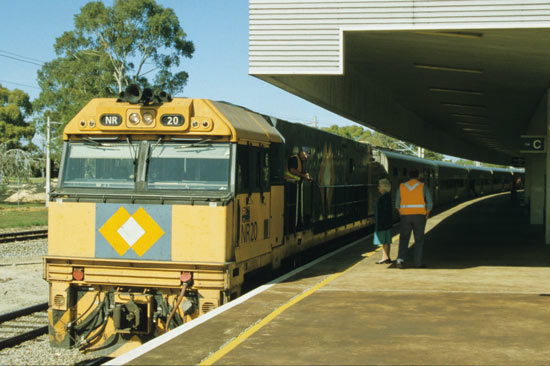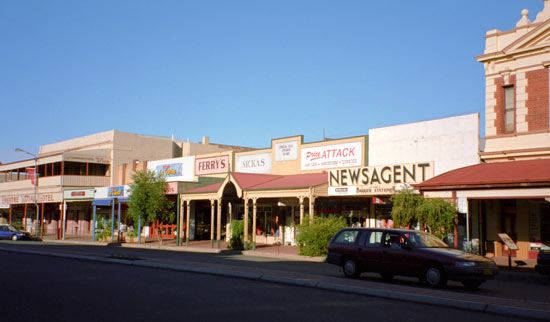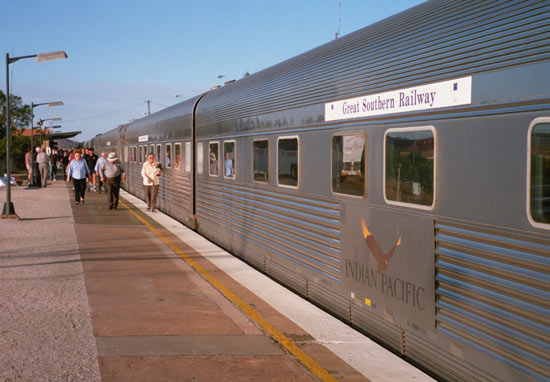
In April 2002 I visited Australia for the first time, and used the Indian Pacific train to cross the continent from west to east. This 4,352km (2705 mile) journey is a great way to appreciate the size and emptiness of this vast country, in comfort.

Although Sydney and Perth have been connected by rail since
1917, different sections of the route had been built with
different track gauges, and it was not until 1969 that a
continuous standard gauge line was established. The first
through passenger train journey from Sydney to Perth was made
by the inaugural Indian Pacific service in February 1970.
My journey was prompted by the Institution of Railway Signal Engineers holding their annual convention in Sydney this year, and I decided that this presented a good opportunity to once again arrive at the convention venue by train. Unlike most other long-distance train journeys that I have made, the Indian Pacific is aimed mainly at the tourist market, and so with no pretence of "travelling with the locals" possible, I decided to indulge myself by travelling "Gold Kangaroo" class. I made my booking on the website of Great Southern Railway, who operate this train as well as The Ghan (Sydney/Melbourne - Alice Springs) and The Overland (Adelaide - Melbourne).
I flew with Qantas from London Heathrow to Perth, via Singapore, and spent two nights in Perth, which provided some time to recover from jetlag and to see a little of this pleasant modern city and its coastal neighbour Fremantle. I was booked on the Friday morning departure of the Indian Pacific, which would get me into Sydney on Monday morning.
 |
A Westrail suburban train at Perth station, on a service to Currambine |
The train departs from East Perth terminal, a short ride on the suburban train from the central Perth station. On arriving at East Perth, I was surprised at the long length of the Indian Pacific, which I estimated as having 22 coaches. I walked up to the head of the train to take a photograph, and then walked almost a quarter of a mile back to coach M, where my compartment was. The coach attendant, Brooke, introduced herself and showed me to my "roomette", a single-occupancy compartment, and explained the facilities and meal arrangements.
The train pulled away on time at 10.55, and headed through the Perth suburbs and into the vast expanse of countryside beyond. After sorting out my luggage as best as I could in the confined space, I decided to go to the lounge car for coffee. There were in fact two lounge cars and two restaurant cars in the Gold section of the train, each pair serving a group of 4 sleeping cars. In the lounge I met some of my fellow travellers, including Charlie, an Englishwoman who thought it would be a good idea if one of the passengers were to be murdered, Orient Express-style, so that the rest of us could occupy our time trying to solve the mystery. The idea was not put into practice.
Meals were served in two sittings, which were given names. I had opted for the second sitting at each meal, and when the "Swagman's Lunch" was announced, I took a seat in the restaurant car. The "Avon Valley" menu, named after the area we were travelling through at that time, offered a choice of two starters, three main courses, and two desserts. I chose the salmon and cream cheese bagel for the main course, accompanied with a glass of white wine. Meals are included in the Gold Kangaroo fare, with drinks paid for extra, but at reasonable prices.
In the afternoon, the Gold Kangaroo manager, Kate, gave a short presentation in the lounge car, introducing the other staff (two of whom were also called Kate), explaining the optional off-train tours, and giving facts about the train. It had 22 coaches, 4 car carriers, and was 680 metres long. She asked passengers where they were from, and most were from eastern Australia, with a number of them returning from their first visit to Perth.
A good book is an essential item on a long journey like this, and I began reading Bill Bryson's book "Down Under", which includes his own experiences on board the Indian Pacific.
Dinner (Moonlight sitting, Southern Cross menu) was very good, with beef steak for my main course. The train arrived in the gold-rush town of Kalgoorlie as we were finishing dinner, and here I had booked for the coach tour of the town during the 3-hour stop. The tour, with commentary from the young lady coach driver, took us around Kalgoorlie, its neighbour Boulder, and to a viewing platform overlooking an enormous hole in the ground, where giant trucks hauled out tons of rock, from which would be extracted a few ounces of gold.
On returning to the train, I went straight to my compartment and went to bed. As usual on a first night on a train, I did not sleep well.
 |
Locomotive NR20 at East Perth terminal, at the head of the eastbound Indian Pacific |
Morning tea was brought to me in my compartment, and looking out of the window the landscape was totally flat and featureless as far as the eye could see. This was the Nullarbor Plain, which we had been crossing for most of the night and would continue to do so until midday. We were also travelling on the longest straight stretch of railway in the world - 478km (297 miles) between Rawlinna and Cook.
Breakfast (Sunrise sitting) in the restaurant car was very English in style, with bacon, egg, sausage and tomato available. Toast and Vegemite provided local flavour.
Shortly after breakfast, the train arrived at Cook for a 2-hour refuelling and servicing stop. Cook was once an important railway town with a population of around 300, but it now has a permanent population of only 4 (or 2, depending on what you read). There was time to visit the former school and hospital, and the inevitable souvenir shop.
Lunch was the Red Hills menu, from which I chose barbecued strips of chicken with salad.
During the afternoon, the train made a brief stop at Tarcoola Junction, where the railway to Alice Springs (and in the future to Darwin) comes in. We had by now left the Nullabor, but the landscape still had little vegetation, and almost no habitation.
After a drink in the lounge, I went for dinner, and had trout for my main course. During the meal, an announcement was made advising us that "train time" would be advanced by 1½ hours to match the local time outside. Why does Australia have this odd half-hour time zone?
Late in the evening, the train called at Port Augusta, the first real town since leaving Kalgoorlie, almost 24 hours earlier.
 |
The Indian Pacific at Cook |
I was woken by the noise of people getting ready for the Adelaide stop, where we arrived at about six o'clock. There was a coach tour of the city available, but I thought that at six on a Sunday morning, the best place to be was in bed. I got up and had a walk on the platform before the train left, and noted that we now had two locomotives at the head of the train, including the one which had brought us all the way from Perth.
We had a new train crew from Adelaide (they are based there, so they work out and back from Adelaide), and my Hospitality Attendant was now Scarlett. As there were now fewer people on the train, there would now be only one sitting for meals, and breakfast was served after departure from Adelaide.
The train retraces its route for a couple of hours, heading north before reaching the junction at Crystal Brook, where it turns right and resumes its eastward course. There were now some villages and small towns, such as Gladstone and Peterborough, but it was still sparsely populated by European standards.
At lunch I sat with a Canadian who had spent six months teaching in Ethiopia, and was on his way home by a roundabout route taking in South Africa, Australia and New Zealand. I think he was also planning to travel across the USA by train.
Soon after lunch the train arrived at Broken Hill, a silver and lead mining centre, and I joined the tour of the town. This included a visit to the Royal Flying Doctor Service base, and an art gallery (one of several in the town). The main thoroughfares are named after minerals, and include such delightful names as Bromide Street and Sulphide Street.
Back on the train, watches were put forward by a further half hour. As dusk fell, I looked out of the window for kangaroos, and spotted three or four, as well as a group of three emus, but there was not enough light for photography.
The evening concluded with the Menindee Menu for dinner, and a nightcap in the bar.
 |
Argent Street, Broken Hill |
 |
The Indian Pacific at Broken Hill station |
Breakfast was taken as the train travelled through the Blue Mountains on the final leg of its journey to Sydney, but it was very misty so there was nothing to see. It was announced that we were running 20 minutes late, but we made slow progress through the Sydney suburbs and lost more time.
Before arrival in Sydney Central station, the train was divided into two portions which ran into separate platforms. Arrival was at 10.00, about 69 hours after leaving Perth. The service on-board the train had been excellent, and the good food, good wine and good company all made it a highly enjoyable experience.
For more information about the Indian Pacific and other long-haul routes in Australia, visit the Great Southern Railway website. There is a good railway enthusiast website at RailPage Australia. There are some more photographs on my Australia page.
 |
Journey's end: Sydney Central terminal. In the background are the two portions of the Indian Pacific. On the left is locomotive NR20, which had worked all the way through from Perth; 8107 on the right had been attached at Adelaide. |